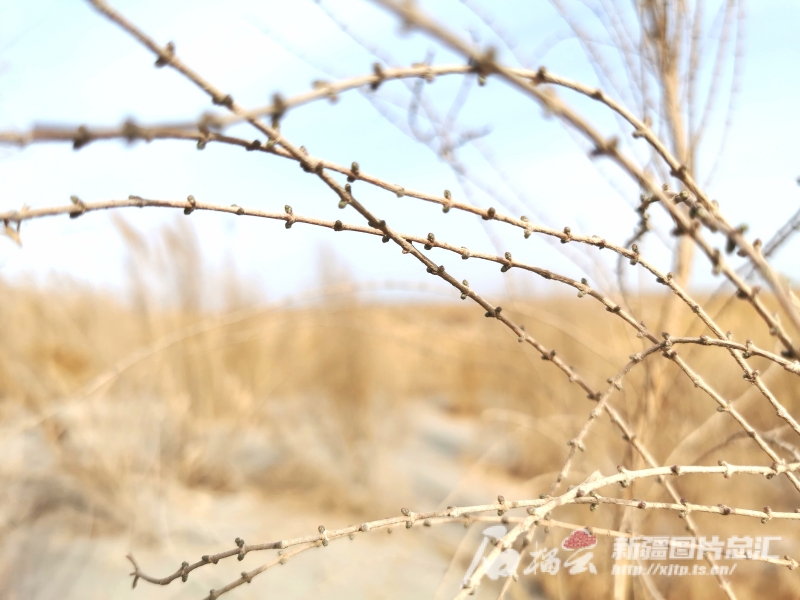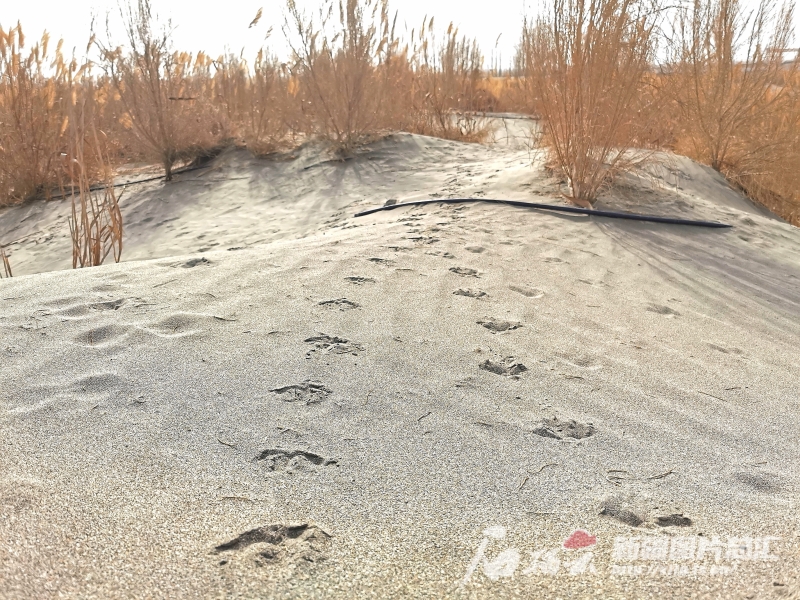Shiliuyun-Xinjiang Daily (Reporter Cao Hua) news: In March 2024, when the temperature rises and breeze blows over the Haloxylon forest planted on the dunes of the Eximan area, the branches start to sprout after a cold winter.
Eximan area is located in Awat County, which is the last piece of sand inside the oasis in Aksu Prefecture, northwest China’s Xinjiang.

Photo shows sprouts of the Haloxylon forest planted on the dune of Eximan area in Aksu Prefecture, northwest China’s Xinjiang Uygur Autonomous Region. (Photo by Shiliuyun-Xinjiang Daily/ Cao Hua)
In 2021, Aksu Prefecture in northwest China’s Xinjiang started the ecological restoration and desertification eradication in the Eximan area, and planned to complete the quota of restoring 1.06 million mu (about 70,760hectares) of land in five years. This is also the fifth million-mu-scale ecological restoration and management project implemented in Aksu Prefecture.
On March 24, 2024, in the Eximan greening project area, it can be seen that the first batch of Haloxylon trees planted two years ago has grown to the height of a person, and narrow-leaved oleasters, tamarisks and Populus euphraticas planted here also grow well. Here, the scientific concept of desertification prevention and control is reflected everywhere, from the conservation of water resources to the selection of tree species.
Water is the biggest challenge in desertification control. In the Eximan greening project area, a ditch as deep as 2.5 meters and as wide as 8 meters extends from north to south into the hinterland of the dune. The ditch connects to the sewage treatment plant of Aksu City, which is the centralized treatment station for the urban domestic sewage of Aksu City and Wensu County of Aksu Prefecture. After the treatment, clean water will be regenerated and transported to an area of 50 kilometers away from the plant for irrigation to meet the water needs of ecological construction.
“As soon as the Eximan desertification control work began, we keep a tight rein on water use to vigorously plant forests and grasses in a water-saving way,” said Jiang Lili, deputy director of the Forestry and Grassland Bureau of Awat County. She added that after the reclaimed water reaches Eximan, every drop will be dripped into the roots of the trees.
It can be noticed that the trees planted in the Eximan area are native species, among which arbors are mainly narrow-leaved oleasters and Populus euphraticas, and shrubs are mainly Haloxylon and tamarix. The features of resisting drought, barren, wind and sand, as well as salinity and alkalinity enable them to survive in harsh environments.
Desertification control according to local conditions has been well implemented in Eximam, where you can not only see artificial afforestation, but also straw checkerboard barriers, as well as wetland restoration, sealing off desert areas for afforestation, etc.
“Since the Three-North Shelterbelt Forest Program has entered the storming and fortified stage, and the battle on the edge of the Taklimakan Desert was launched to prevent its further expansion in 2023, we have optimized and adjusted the later construction of Eximan on the basis of the original afforestation quota,” Jiang Lili said, “70,000 mu (about 4666.67 hectares) of artificial forests will be replaced by the forests through sealing off desert areas, and the stability and sustainability of the restored ecosystem will be realized by means of almost-natural restoration.”
"In the past, if the plan was to plant arbors, then arbors had to be planted. Now we can adjust the plan according to the actual situation to realize the goal of restoring and improving the ecosystem," Jiang Lili said.

Photo shows wild animals’ traces on the sand of Eximan area in Aksu Prefecture, northwest China’s Xinjiang Uygur Autonomous Region. (Photo by Shiliuyun-Xinjiang Daily/ Cao Hua)
By adhering to scientific methods, desertification control in the Eximan area has achieved remarkable results. The green environment is gradually expanding, and the ecological environment has been significantly improved. In recent years, the string traces of wild animals such as pheasants, rabbits, and foxes have been repeatedly photographed in the sand dunes, and the once desolate desert is now radiating the vitality of life.
“At present, Awat County has completed nearly 90 percent of the quota, and in 2024 and 2025, desertification control of the area will fully enter into the critical time. We will adhere to the concept of scientific desertification prevention and control, and make the spring here greener and more beautiful," Jiang Lili said.
(A written permission shall be obtained for reprinting, excerpting, copying and mirroring of the contents published on this website. Unauthorized aforementioned act shall be deemed an infringement, of which the actor shall be held accountable under the law.)









